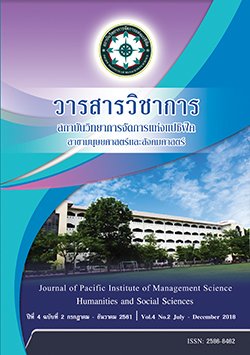Development of Reading Instructional Model through Task Based Approach Integrating with Collaborative Strategic Reading (CSR) and SCAMPER Techniques to Enhance Creative Thinking of Vocational Diploma Students
Keywords:
Task Based Approach, Collaborative Strategic Reading (CSR), SCAMPERAbstract
The objectives of this research were to: 1. construct the Reading Instructional Model through Task Based Approach Integrating with Collaborative Strategic Reading (CSR) and SCAMPER Techniques to Enhance Creative Thinking of Vocational Diploma Students, 2.investigate the effectiveness of the Reading Instructional Model based on the assigned criteria 80/80, 3.compare students’ reading comprehension ability between pre-test and post-test, 4. evaluate students’ creative thinking ability after using the Reading Instructional Model, and 5. evaluate multiple reading comprehension strategy usage of students after using the Reading Instructional Model. The samples of this research were 401st year diploma students majoring in Accounting, who enrolled in Academic year B.E. 2560 for the course of Business English at Rayong Technical College, selected by Random Sampling technique. The experiment was carried out for 18 weeks, 54 hours in total. The research results were 1) the Reading Instructional Model through Task Based Approach Integrating with Collaborative Strategic Reading (CSR) and SCAMPER Techniques to Enhance Creative Thinking of Vocational Diploma Students consisted of 4 components; principles, objectives, teaching and learning procedures, and evaluation and was named the ”CRTE Model„, consisting of four steps: ”Conceptualizing„ (C), ”Reacting„ (R), ”Thinking Creatively„ (T), and ”Evaluating„ (E), 2) the efficiency of the model was 83.46/ 82.90, meeting the E1 / E2 standard, 3) the students’ reading comprehension abilities scores obtained in post-test were significantly higher than pre-test at .01 level of statistical significance, 4) students’ creative thinking performance after using the Reading Instructional Model passed the set
*This article is published to fulfill the requirement for Ph.D in Curriculum and Instruction, Silapakorn University, Thailand.
**Richavee Chatviriyawong, Department of Foreign Language, RTC, richavee@yahoo.com
***Assco. Prof. Dr. WisaChattiwat, Faculty of Education, Silapakorn University, wisachat@gmail.com
criteria (70%), in Satisfactory level, and 5) students’ usage of multiple reading comprehension strategies after the implementation of the Reading Instructional Model in overall was in the highest level.
Downloads
Published
Issue
Section
License
บทความที่ได้รับการตีพิมพ์เป็นลิขสิทธิ์ของ สถาบันวิทยาการจัดการแห่งแปซิฟิค
ข้อความที่ปรากฏในบทความแต่ละเรื่องในวารสารวิชาการเล่มนี้เป็นความคิดเห็นส่วนตัวของผู้เขียนแต่ละท่านไม่เกี่ยวข้องกับสถาบันวิทยาการจัดการแห่งแปซิฟิค และคณาจารย์ท่านอื่นๆในสถาบันฯ แต่อย่างใด ความรับผิดชอบองค์ประกอบทั้งหมดของบทความแต่ละเรื่องเป็นของผู้เขียนแต่ละท่าน หากมีความผิดพลาดใดๆ ผู้เขียนแต่ละท่านจะรับผิดชอบบทความของตนเองแต่ผู้เดียว







